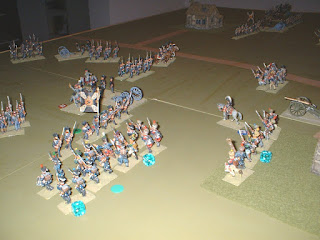CAMPAIGN DIARY
Move 1 – 0800-1200 1 May 1813
Prussian and French armies reach their concentration areas
Move 2 – 1200-1600 1 May 1813
The Prussian Army nears the river Saale, and 3 corps secure the bridge at
The French Army have reached their concentration areas around Helmstedt.
Move 3 – 1600-2000 1 May 1813
3 Prussian corps crossed the river Saale and entered
4 and 13 French corps both try to pass through
Move 4 – 0800-1200 2 May 1813
The Prussians have now crossed the river Saale at Parey in the north and
The French traffic jam at
Move 5 – 1200-1600 2 May 1813
The Prussians have crossed the river Saale and 2 corps is approaching Magdeburg
The French continue their advance towards Magdeburg.
Move 6 – 1600-2000 2 May 1815
The Prussians have crossed the river Saale and are moving west when they sight the French army approaching them from Seehausen.
Move 7 – 1200-1400 3 May 6 May 1813
1 Prussian and 4 French corps fight the battle of Colbitz
2 Prussian and 5 French corps fight the battle of Seehausen
Move 8 – 1400 -1600 3 May 1813
The French win the battle of Colbitz. 4 French corps enters the town. 1 Prussian corps withdraws towards Parey
Battle of Seehausen continues. 2 Prussian and 5 French corps exchange fire. Marshal Davout and 6 French corps join the battle..
Move 9 – 1600-2000 3 May 1813
Battle of Seehausen continues. 3 Prussian corps joins the battle, just in time to add much needed support to the weary Prussian army
At midnight both commanders in chief give orders to continue the battle the next day.
Move 10 – 0800-1200 4 May 1813
The Battle of Seehausen continued with the arrival of 4 Prussian corps and 13 Polish corps, plus Marshal Blucher. However the tide quickly went against the Prussians and by 1100 two corps were in rout and a third desperately trying to hold the French advance
The approach of 4 French corps proved the final straw, and the Prussians withdrew towards
CAMPAIGN NOTES
For three hours the Prussian army held their own against the French attack.
On the left 5 French corps finally took possession of the village, and advanced against 2 Prussian corps. The two exchanged skirmish and later musket fire for two hours, both suffering heavy casualties.
In the centre both 13 Polish and 4 Prussian corps advanced towards the T junction in the centre of the battlefield. The Poles had further to march and made slow progress. The Prussian cavalry advanced to threaten 5 French corps, but received casualties from their artillery. This resulted in loss of morale and a subsequent rout, which took the gunners with them. The remainder of the corps made their morale, but were badly shaken.
On the right 6 French corps were inflicting heavy casualties on 3 Prussian corps. At 1100 the first Prussian brigade broke and ran, and within half an hour two more had joined them. The Prussian right wing was on the verge of collapse.
At 1200 4 French corps advanced against the Prussian right wing. Already badly shaken, the entire Prussian army broke and ran towards
In the two day battle the French lost 13 infantry and 8 cavalry. The Prussians lost 16 infantry and 9 cavalry.
Campaign situation
The situation is now desperate for Marshal Blucher and the Prussian army. By midday his army have been forced back to the banks of the river
Game mechanics
Both armies were badly shaken by battle casualties. Although the actual numbers may seem light, it should be remembered that each casualty in these rules results in a loss of morale and fighting ability with minus 1 for each casualty. One casualty per brigade is manageable, but anymore than that would reduce the fighting ability and morale so as to make the brigade unable to maintain a combat.
The arrival of 4 French corps made the odds too great in favour of the French. In addition there were no fresh Prussian troops available within three or four moves who could ease the pressure.
The final straw was that the Prussians were unable to withdraw over the river
























